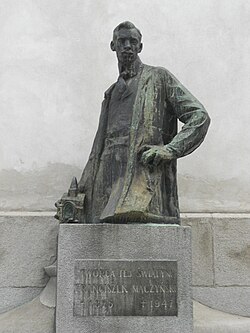Franciszek Mączyński: Difference between revisions
start page |
m clean-up, typo(s) fixed: Krakow → Kraków (3) using AWB |
||
| Line 5: | Line 5: | ||
Mączyński was born in [[Wadowice]] in southern Poland. He trained with architect Slawomir Odrzywolski, and in 1900 he won an international architectural competition organized by the Paris-based magazine "Moniteur des Architectes" with a design of a villa in the ethnic [[Zakopane Style architecture|Zakopane style]].<ref>http://www.zakopane.eu/index.php?option=18&action=articles_show&art_id=2036</ref> He continued his studies at the [[Jan Matejko Academy of Fine Arts]] under [[Konstanty Laszczka]] from 1902 to 1904, and finished his education in Vienna and Paris. |
Mączyński was born in [[Wadowice]] in southern Poland. He trained with architect Slawomir Odrzywolski, and in 1900 he won an international architectural competition organized by the Paris-based magazine "Moniteur des Architectes" with a design of a villa in the ethnic [[Zakopane Style architecture|Zakopane style]].<ref>http://www.zakopane.eu/index.php?option=18&action=articles_show&art_id=2036</ref> He continued his studies at the [[Jan Matejko Academy of Fine Arts]] under [[Konstanty Laszczka]] from 1902 to 1904, and finished his education in Vienna and Paris. |
||
Mączyński's work is concentrated in |
Mączyński's work is concentrated in Kraków. Already prominent by 1910, his commissions include several major churches, and turn-of-the-century civic and cultural institutions designed in a Polish-influenced [[Vienna Secession|Secession style]]. In 1936 he was awarded the Golden Laurel of the [[Polish Academy of Literature]]. |
||
== Work == |
== Work == |
||
Mączyński's work includes (in |
Mączyński's work includes (in Kraków unless otherwise noted): |
||
* the Press Palace, with Tadeusz Stryjeński, 1920-1921 |
* the Press Palace, with Tadeusz Stryjeński, 1920-1921 |
||
* the |
* the Kraków Chamber of Commerce <ref>Cracow, the royal capital of ancient Poland: its history and antiquities, by Leonard Lepszy, page 11</ref> |
||
* House Under the Globe |
* House Under the Globe |
||
* Palace of Art (''Pałac Sztuki'') |
* Palace of Art (''Pałac Sztuki'') |
||
Revision as of 17:24, 22 November 2013

Franciszek Mączyński (1874 - 1947) was a Polish Art Nouveau architect.
Mączyński was born in Wadowice in southern Poland. He trained with architect Slawomir Odrzywolski, and in 1900 he won an international architectural competition organized by the Paris-based magazine "Moniteur des Architectes" with a design of a villa in the ethnic Zakopane style.[1] He continued his studies at the Jan Matejko Academy of Fine Arts under Konstanty Laszczka from 1902 to 1904, and finished his education in Vienna and Paris.
Mączyński's work is concentrated in Kraków. Already prominent by 1910, his commissions include several major churches, and turn-of-the-century civic and cultural institutions designed in a Polish-influenced Secession style. In 1936 he was awarded the Golden Laurel of the Polish Academy of Literature.
Work
Mączyński's work includes (in Kraków unless otherwise noted):
- the Press Palace, with Tadeusz Stryjeński, 1920-1921
- the Kraków Chamber of Commerce [2]
- House Under the Globe
- Palace of Art (Pałac Sztuki)
- Concert Hall of the Musical Society[3]
References
- ^ http://www.zakopane.eu/index.php?option=18&action=articles_show&art_id=2036
- ^ Cracow, the royal capital of ancient Poland: its history and antiquities, by Leonard Lepszy, page 11
- ^ Cracow, the royal capital of ancient Poland: its history and antiquities, by Leonard Lepszy, page 11
